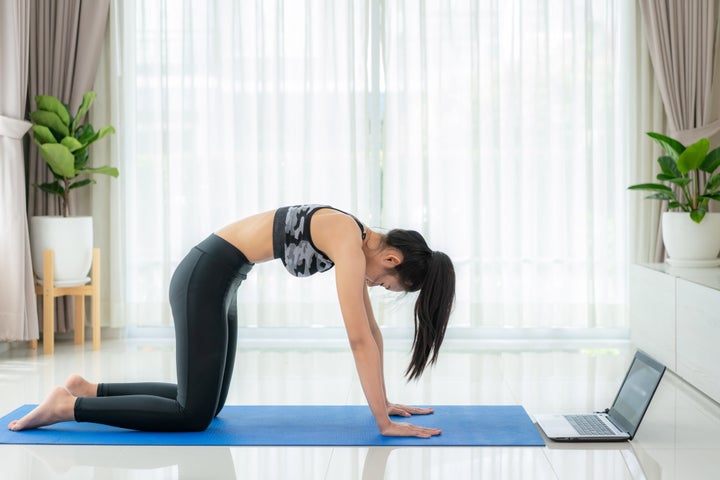
When it comes to dealing with back pain, there’s some good news and bad news. The good news is that, in many cases, regular back pain isn’t serious.
“About 85% to 90% of back pain is mild to moderate and does not need to be treated by a doctor,” said Neel Anand, a professor of orthopaedic surgery and the director of spine trauma at Cedars-Sinai Medical Centre in Los Angeles. “It’s often an inflammatory issue that will go away on its own, with an over-the-counter anti-inflammatory medication.”
The bad news? Even back pain that isn’t “serious” is still pretty painful to deal with on a day-to-day basis.
Plus, Anand said, wear and tear on your back can happen as early as in your 20s and only continue from there. Add that on top of your possibly less-than-ideal home office setup from the last year. Chances are, all that slouching you did on the couch answering emails every day is starting to take a toll.
Thankfully, there are some simple moves that will help keep you loose for most of the day. Below, experts share six stretches to do every morning if you’re dealing with back pain. Pair these with your usual fitness routine and you’ll notice more mobility and less stiffness within a week or two. (Just remember, if you find your pain isn’t letting up after four to six weeks, is worsening or is accompanied by leg pain or weakness, mention it to your health care provider immediately.)
Cat-Cow
“This is one of my favourite spinal mobility stretches to do, particularly during the pandemic since we’ve all been homebound and likely hunched over a lot,” said Christina Rodriguez, a board-certified orthopaedic specialist and physical therapist at the Hospital for Special Surgery in New York.
To do a cat-cow, start on your hands and knees. Place your wrists under your shoulders and your knees under your hips. Inhale as you arch your back gently, stomach dropping toward the floor and gaze lifting up to the ceiling. (This is cow pose.) As you exhale, draw your stomach to your spine, and round your back to the ceiling. Your chin and gaze should be pointed down at the mat. (This is cat pose.) Repeat 10 times (or as many as you feel comfortable doing) to help loosen things up and improve your range of motion.
Upper Back Foam Roller Stretch
Rodriguez said this stretch works best with a foam roller, but a rolled up, thick blanket or yoga bolster will also do the trick.
Start on the floor with your knees bent. Place the foam roller underneath your shoulder blades and interlace your hands behind your head. Using your legs to push you, roll the foam roller up and down your upper back slightly. Repeat for 10 reps.
“Another option is to use a chair that has a middle-high chair back,” Rodriguez added. “Arch your back up along the back of the chair for 10 seconds to get a similar stretch.”

Seal Pose
Start flat on your stomach with your palms down underneath your shoulders. Keep your legs and hips on the ground as you press yourself up. Hold for three to five seconds and lower back to the starting position. Repeat for 10 reps.
“This will target your lower back and is also great for people who find themselves sitting for most of the day,” Rodriguez said.
Spinal Twist
Sitting in a chair with your feet flat on the ground, use the arms of the chair to turn just your upper body to the right. Hold and repeat on the left side.
You can also do this move on the floor for a deeper stretch: Start flat on your back and bring your right knee up to your chest. Then bring it over to the left side as you look over your right shoulder. Hold it for a few seconds, then on the left side by bringing the left knee up to your chest then over to the right side and you look over your left shoulder.
“If you don’t stretch often this might make you feel a little uncomfortable, but there should never be any sharp pain when stretching,” Rodriguez said. “Make sure to listen to your body and if something doesn’t feel right, back off a bit.”
Hamstring Stretch
“Tightness in the hamstrings can cause a person to have to use their back more when bending forward,” said Susan Fu, manager of rehabilitation services at Providence Saint John’s Health Center’s Performance Therapy in Santa Monica. “The hamstring stretch is great because it will decrease tension across the back and improve the hip mobility in the posterior chain.”
Start with a wall hamstring stretch: Lie on your back and keep one leg on the floor. Place the other against a wall as straight as possible without overextending the knee. Hold for 10 seconds and switch legs.
Piriformis Stretch (Pretzel Stretch)
Lie flat on a mat or the floor face up and cross your right ankle over the left thigh (your left leg should be bent, foot flat on the floor). Place your hands under your left knee and gently pull toward your chest. Hold for 10 seconds and switch sides, crossing your left ankle over the right thigh.
“This stretch will help with hip rotation, overall mobility, and can decrease the tightness in the piriformis muscle (which is near your glute) that may compress on the sciatic nerve and cause back pain,” Fu said.